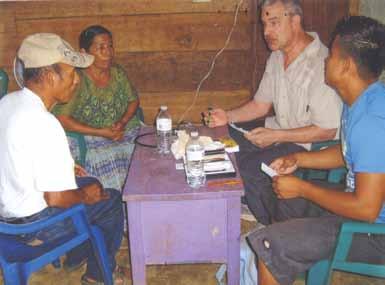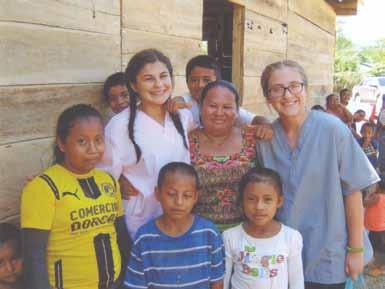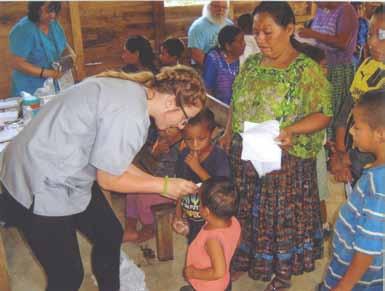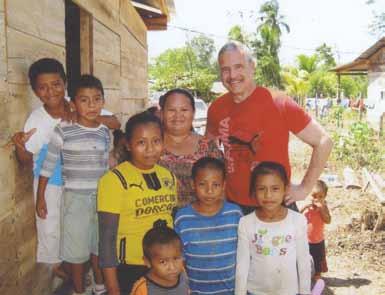
12 minute read
Dr.Hanson
No one said it was going to be easy...
Roan Mountain physician finds mission field rewarding Dr. Wes Hanson is pictured with his granddaughters, Kali and Krisi, and members of a Guatemalan village. Dr. Hanson visited three villages while on his mission trip.
Advertisement
Dr. Wes Hanson has lived and worked in Roan Mountain for 30 years where he is the primary care doctor for countless members of the Roan Mountain community. During that time, he has helped to heal their wounds, comfort their spirits, and make a difference in many households in the community.
In the summer of 2019, he decided it was time to take his act on the road and travel to Guatemala. The trip was part of a mission trip that his church had set up so Dr. Hanson decided to take his skills and medicine to the people of Guatemala where the mission trip was intended to serve.
It turns out that the trip will be one that the physician will never forget.
“My church, Roan Mountain First Baptist Church, decided to take a mission trip to one of the underdeveloped nations. We decided to go to Guatemala because we saw a need for medical care and for medicines there.
“We took 13 people from our church including our pastor, Geren Street, and we met four people from Alabama who went along to help. Once we got in Belize, we picked up a couple who went along to translate the language for us.”
Along with being away from home and in a location
where little was to be known of what to expect, one of the greatest obstacles the group had to face was how to communicate with the people in the area that the mission group was going to.
Fortunately for the group, the decision to pick up the couple who served as interpreters was the most important pickup on the trip. “We discovered that though most of them speak Spanish, the Mayans of Guatemala have their own dialect so the interpreters were invaluable.” * Story by Danny Blevins and Photos Contributed *




35 For all that have been on a mission trip, the vision that might be formulated is one of a sight-seeing adventure in a country far from home. Unfortunately, those same people find out sooner than later that other countries are not as blessed as the United States and this part of the country is.
Leaving the comfort zone of Roan Mountain might have been difficult for others but not for Dr. Hanson who realized that things that are worthwhile are always hard.
“I was not concerned about leaving the country but it was just a hassle to get a passport. We also had to learn the do’s and don’ts of this region and a little of their culture,” according to Hanson.
“The biggest health risk for us was the water. We were told not to drink the water, and we were given several bottles of water a day to help us.”
To make matters worse, the team selected a time of year that presented challenges of its own especially dealing with the heat of the country located in Central America.
“We really went down at a bad time of the year because of the heat,” stated Hanson. “We went the second and third week of June and Guatemala is near the equator.
“It was 95 degrees or more every day and the humidity made it miserable. I think the heat index was 105 degrees every day. We were told to drink at least four bottles of water a day.”
In his practice in Roan Mountain, Dr. Hanson is accustomed to having everything that he needs to treat his patients at arm’s length as well as having enough staff to help make sure his patients are taken good care of while they wait to see him by taking their vitals and other information.
Though Dr. Hanson took with him the skills that have served him well in his practice, he still counted on others for the day-to-day duties of having a medical clinic.
Furthermore, Dr. Hanson was the only physician on the trip. “I was the only doctor but there was more than enough to do for everyone on the trip,” Dr. Hanson said. “We needed people to take blood pressures, check sugar levels and keep records.
“I took my grandchildren with me, Krisi and Kali, and they did things like that.”
One can imagine that there is a fear of just being on a trip such as the one Dr. Hanson elected to participate in. There have been stories in the past of people who have gone on mission trips and were kidnapped or even killed.
It could be especially challenging for a physician as countries who do not have the skills such as Dr. Hanson could look at an individual as being a valuable commodity to their villages and raise the risk of being kidnapped.
For Hanson, this fear didn’t cross his mind but having his two granddaughters along with him did make him think a little differently.
“If I feared anything on this trip, it was for my granddaughters. But I wanted to take them on this trip to expose them to other parts of the world and to other cultures,” Hanson commented.
“I know the first time I left the country it changed me, and I hoped it would make a difference for them. I think it did.”
The trip itself was filled with the opportunity to provide health services to those who may have had sickness and illnesses that hadn’t even been diagnosed.
One of the difficult parts for Dr. Hanson was the fact that even in Krisi and Kali are pictured with members of a Guatemalan village. The trip changed the lives of both of Dr. Hanson’s granddaughters.
Dr. Hanson’s granddaughter Krisi gives a diabetic test to one of the Guatemalan residents.
Dr. Hanson meets with a patient in his make-shift office. One of the worst problems in the villages was the presence of intestinal worms. According to Dr. Hanson, 40 percent of his patients had this problem.


36 being able to diagnose some patient’s issues, the realization that they might not even be able to afford the medicine and care needed to get better was a large consideration to be taken.
“We got to spend four days with the people, and it will change you,” Dr. Hanson said. “We would go to a village and people would come from all around the area.
“They would wait in line for hours to get treatment and they were so patient. This is one thing that was different about the people down there and here in the states.
“They would wait for hours and still have a smile on their face when you finally got to see them!
“We went to three different villages and tried to diagnosis their sickness and dispensed what medicine we had with us,” continued Dr. Hanson. “We could have helped a lot more people if we had taken different medicines but we just could not take everything.”
As a physician, it’s not uncommon to see different illnesses and have the desire to help. After all, that is why an individual should enter the field of medicine to begin with.
However, the difference in being able to diagnose and being able to actually help someone often presents barriers that a physician cannot heal.
“One man came to us who obviously had Parkinson’s. I told him what was wrong, but I could not help him. He would have to get the medicine somewhere else, and I doubt he could afford it. It was really heartbreaking,” Dr. Hanson stated.
Guatemala is no different from the United States in the fact that diseases such as diabetes and arthritis exist but there are other health issues that come with the conditions that are found in the country and especially in the various villages that are spread throughout the region. One of the diseases that run rampant in the Central American country is intestinal worms.
“Forty percent of the villagers have intestinal worms, and we took plenty of worm medicine,” Dr. Hanson added. “They contract these from undercooked meat and through their feet. Many of them do not wear shoes, and they get them from the dirt.
“Another medical problem we encountered was scabies. Several people in every village had scabies.
“I remember one guy came to us with an itch that had lasted for five years. It was scabies, and he was very grateful when we gave him something to help it.”
While many may have a scaled vision of what the people of these villages might be like in real life, there is a stark difference to what is thought to what reality truly is.
This was quickly learned by Dr. Hanson and his group as they encountered many villagers while providing medical care to the villages. “The people of the villages were so kind to us and sometimes even brought things for us to eat. They are very loving people,” said Dr. Hanson.
Hanson said there would be no hesitation to return and provide further medical care to the region. And while medical care was one of the reasons for going, one of the main reasons was to bring the people a different message.
A message of the gospel of Jesus Christ as the medical care opened doors for the Gospel to be shared with those who were seeking physical healing but were giving the news of a spiritual healing as well. When I asked if he would go again, he did not hesitate. “Absolutely. We were able to bring medical care to them and also share the gospel with them. We helped the patients medically, and then a Christian counselor talked to them. Everyone got some one-on-one time with the counselors, and I think we made a difference,” Dr. Hanson stated.
One of the big advantages of the trip for Dr. Hanson was just spending a week with other Christians and his granddaughters.
“It was so good to spend a week with other Christians, and I think the trip really helped my granddaughters, Kali and Krisi. I know they came back as different people.”
Dr. Hanson is looking forward to another mission trip. “I hope I get to go again,” Dr. Hanson said. “We were able to help others, but it made a difference and changed who I am. I learned that things that are worthwhile are always hard.
“People should get out of their comfort zones and then they can grow as a person. They will live through it and they will make a difference. Basically, that is why we are put on earth, to help our fellowman.” Dr. Hanson is pictured with some of the Guatemalan people he tried to help on his recent visit.
Dr. Hanson’s granddaughter, Kali, gives aid to a Guatemalan child. Dr. Hanson was especially impressed with the patients and appreciation of the villagers.
Peanut butter and chocolate: a pairing for the ages

Few dessert pairings are as beloved as chocolate and peanut butter. These are strong flavors that are coveted on their own, and especially so when eaten together. When packed in a decadent terrine, peanut butter and chocolate take indulgence to new heights. Whether hosting a gathering at home or preparing a dessert for family, this recipe for “Chocolate-Peanut Butter Terrine with Sugared Peanuts” from “Classic Stars Desserts” (Chronicle Books) by Emily Luchetti is sure to please. For best results, use chocolate with 58 to 62 percent cacao, rather than a chocolate of higher percentage. Chocolate-Peanut Butter Terrine with Sugared Peanuts Serves 8
Terrine 11 ounces bittersweet chocolate, finely chopped
1 ounce unsalted butter 6 tablespoons creamy peanut butter
4 large egg yolks 1⁄4 cup granulated sugar 13⁄4 cups whipping cream Glaze 4 ounces bittersweet chocolate, finely chopped
21⁄2 ounces unsalted butter 2 teaspoons light corn syrup Sugared Peanuts 1 large egg white 6 tablespoons granulated sugar 11⁄2 cups unsalted peanuts Spray an 81⁄2-by-41⁄2-by23⁄4- inch loaf pan with nonstick spray. Line the sprayed pan with plastic wrap, allowing a 11⁄2-inch overhang on all sides.
In a stainless-steel bowl, combine the chocolate, butter, and peanut butter. Place the bowl over a pan of simmering water, making sure the bottom of the bowl does not touch the water. Heat, stirring occasionally, until the chocolate and butter melt. Remove from the heat and whisk until smooth.
Combine the egg yolks and sugar in the bowl of a stand mixer fitted Chocolate-Peanut Butter Terrine with Sugared Peanuts
with the whip attachment and whip on high speed until thick, about 1 minute. Remove the bowl from the mixer stand. Using a wooden spoon, stir in the chocolate mixture in 3 equal additions. The mixture will be quite thick.
In a separate bowl, whisk the cream until it starts to thicken. Using a spatula, fold the cream into the chocolate mixture in 4 equal additions. Spread the batter in the prepared pan. Cover with the plastic wrap overhanging the sides and refrigerate until firm, at least 4 hours. To unmold the terrine, fold back the plastic wrap and invert the pan onto a wire rack. Pull on a corner of the plastic wrap to release the terrine from the pan. Lift off the pan and carefully remove the plastic wrap. Line a baking sheet with parchment paper and place the rack on it. Return the terrine to the refrigerator while you make the glaze.
To make the glaze, in a stainlesssteel bowl, combine the chocolate, butter and corn syrup. Place the bowl over a pan of simmering water, making sure the bottom of the bowl does not touch the water, and heat, stirring occasionally, until the chocolate and butter melt. Remove from over the heat and whisk until smooth. The glaze should be pourable but not so thin that it will run off the terrine. If the glaze is too thin, let it sit at room temperature for about 30 minutes.
Slowly pour the glaze evenly over the top of the terrine, allowing it to stream evenly down the sides. With an offset spatula, spread the glaze to cover the terrine smoothly and completely. Refrigerate until the glaze is set, about 30 minutes.
To make the sugared peanuts, preheat the oven to 350 F. In a bowl, whisk the egg white until frothy. Whisk in the sugar. Add the peanuts and mix until they are evenly coated with the mixture. Spread the peanuts in a single layer on a rimmed baking sheet and place in the oven. Toast the nuts, stirring them every 5 minutes, until dry and golden brown, 15 to 20 minutes.
To serve, transfer the terrine to a serving platter and arrange the sugared peanuts on top. Cut the terrine with a hot, dry knife.








